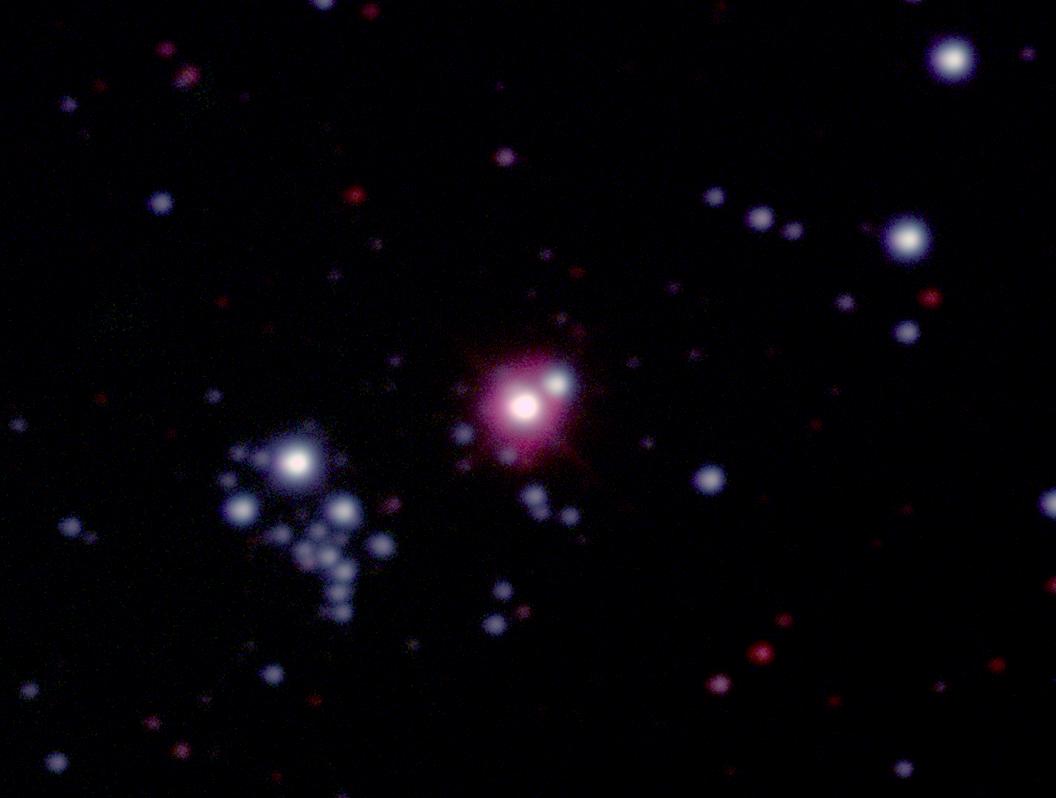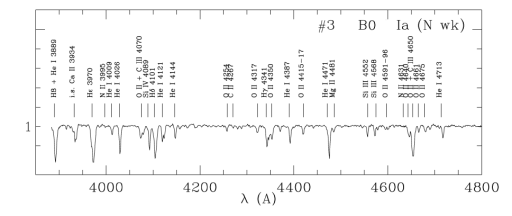
R127 and its massive star cluster
R127, one of the most spectacular variable massive stars in the Large
Magellanic Cloud, has barely been studied from the viewpoint of its
association with a massive star cluster. However such a study reveals
new hints about the processes leading to the formation of an
extraordinary Luminous Blue Variable (LBV) like R127. A team of
astronomers from Paris Observatory and the Space Telescope Science
Institute (Baltimore) has performed the most detailed study of the
stellar environment of R127. Using the European Southern Observatory's
NTT telescope and a powerful image restoration algorithm, they achieve
an angular resolution of 0".26, which enables them to resolve R127
into at least 14 components. The spectral classification as
well as the photometry allows studying the history of star formation
in this interesting region of our neighbour galaxy.
The most luminous object of the R127 cluster belongs to the very rare class of LBVs, which has only a dozen confirmed members in the Large Magellanic Cloud. These most luminous stars are characterized by irregular photometric and spectral variations over decades and transform from a hot (OB type) visual minimum phase to a cooler (A) type at visual maximum. In the H-R diagram they are located very close to the observed upper luminosity boundary for very massive stars, the Humphrey-Davidson limit. They are characterized by extreme instability, dramatic outbursts and high mass loss. LBVs are believed to be the precursors of Wolf-Rayet stars; however their precise evolutionary state is still poorly understood. It is therefore necessary to study every aspect of these rare stars in order to constrain theoretical models.
R127 is an odd object even among this extraordinary family of stars: it is the most luminous LBV in the Large Magellanic Cloud (bolometric magnitude of -10.5), and has shown the most intense light variations (about 2.5 mag in the V band). Shortly before its recorded maximum in 1986, R127 was the brightest object of the Large Magellanic Cloud, until the supernova event in 1987. From 1989 until 2000 its brightness decreased, and it has been increasing since.

|
| The massive star clusters R127 and R128 after image restoration, performed on two sections of an original 256 x 256 pixels image. A resolution of 0".26 was achieved thanks to an innovative deconvolution method developed by Magain et al., which optimizes the deconvolution of CCD images and conserves the flux and position of the stars. R127 is resolved into 14 components, R128 into 33. The closest detected neighbor of R127, star #8, is 1".5 away. The brightest neighbor, star #3, is situated 3".3 from the LBV. |
Spectroscopy was obtained for 19 stars associated with the R127/R128 clusters, using the ESO NTT telescope equipped with EMMI. It turns out that the most luminous stars of these clusters are giants or supergiants of spectral type O and, for a smaller number, B. The study of the H-R diagram, involving comparison with models of stellar evolution, yields information about the present and past characteristics of the stars. The team of astronomers arrives at the conclusion that the LBV object was born about 3 million years ago as the most massive star of the R127/R128 clusters, with a mass of about 85 solar masses. Comparison with its present mass indicates that the LBV has lost about 45% of its original mass, with a mean mass loss rate of around 10-5 solar masses per year.
The next brightest and hottest stars of the group are two supergiants with initial masses of about 80 solar masses, formed about 3 million years ago. Less massive stars have ages of 3 to 5 million years. It seems therefore that the most massive stars have formed after the formation of less massive stars.
Reference:
M. Heydari-Malayeri, F. Meynadier and Nolan R. Walborn,
Tight LMC massive star clusters R127 and R128 (A&A: accepted 07/01/2003)
Prepublication: astro-ph/0301298
Contact


 Frédéric Meynadier (Observatoire de Paris, LERMA)
Frédéric Meynadier (Observatoire de Paris, LERMA)

